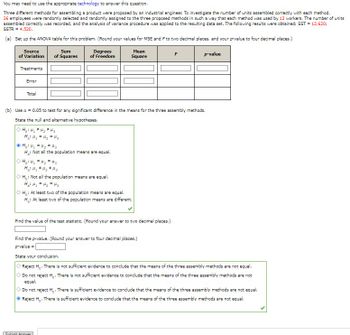
Glencoe Algebra 1, Student Edition, 9780079039897, 0079039898, 2018
18th Edition
ISBN: 9780079039897
Author: Carter
Publisher: McGraw Hill
expand_more
expand_more
format_list_bulleted
Question

Transcribed Image Text:**ANOVA Analysis for Comparing Assembly Methods**
To determine if there is a significant difference in the number of units assembled correctly among three different assembly methods, an industrial engineer conducted an experiment with 36 employees. Each method was used by 12 workers, and the number of correctly assembled units was recorded. The analysis of variance (ANOVA) procedure was applied to this data. Below is the detailed transcription and explanation of the analysis:
### Data and Instructions for ANOVA Table
| **Source of Variation** | **Sum of Squares** | **Degrees of Freedom** | **Mean Square** | **F** | **p-value** |
|--------------------------|----------------------|-----------------------------|-----------------|--------|-------------|
| Treatments | | | | | |
| Error | | | | | |
| Total | | | | | |
- SST (Total Sum of Squares) = 12,620
- SSTR (Sum of Squares due to Treatments) = 4,520
### Steps and Hypotheses
**(a) Setup of ANOVA Table**
Calculate the degrees of freedom for each source of variation:
- **Treatments (Between Groups)**: k - 1 (where k is the number of groups)
- **Error (Within Groups)**: N - k (where N is the total number of observations)
- **Total**: N - 1 (sum of the two above degrees of freedom)
Use the given formulas:
- **Mean Square**: MS = SS/df
- **F-ratio**: F = MST/MSE
**(b) Hypothesis Testing**
Using **α = 0.05**, test for a significant difference in means among the three assembly methods.
**Hypotheses:**
- **Null Hypothesis (H0)**: μ1 = μ2 = μ3 (All means are equal)
- **Alternative Hypothesis (Ha)**: Not all means are equal
Since the hypotheses are about comparing three methods (μ1, μ2, μ3), the selected hypotheses are:
- **H0: μ1 = μ2 = μ3**
- **Ha: Not all the population means are equal**
**Conclusion Derivation**
Find the **test statistic** from the ANOVA table and compare it against the F-distribution critical value or directly assess the **p-value** against the significance level (
Expert Solution
This question has been solved!
Explore an expertly crafted, step-by-step solution for a thorough understanding of key concepts.
Step by stepSolved in 3 steps

Knowledge Booster
Similar questions
- how to find the Variance for CBT and variance for BT,show step by step pleasearrow_forwardBackground: The butterfat content of random samples of Guernsey, Holstein and Jersey cows are provided below. Each data value represents the percentage butterfat. Directions: Perform an analysis of variance (ANOVA) to determine if the differences in the percentage butterfat of the different breeds of cows is statistically significant. Click on the Data button below to display the data. Copy the data into a statistical software package and click the Data button a second time to hide it.Data Guernsey Jersey Holstein 4.59 5.03 3.22 5.2 6.55 3.67 5.61 5.27 3.61 5.04 4.44 3.92 4.72 5.33 4.21 4.64 5.49 3.77 4.53 5.43 3.12 3.92 4.93 3.95 5.09 5.17 3.54 4.67 4.98 3.5 5.24 5.96 3.89 4.56 5.28 3.71 4.76 5.31 3.81 4.98 4.74 3.33 4.72 5.08 3.91 4.61 4.17 3.95 4.82 6.06 5.36 4.86 5.45 6.18 Choose the correct null and alternative hypotheses. H0: μ1=μ2=μ3H0: μ1=μ2=μ3Ha: μ1,μ2,μ3Ha: μ1,μ2,μ3 are not all equal. Ha: μ1,μ2,μ3Ha: μ1,μ2,μ3 are…arrow_forward
arrow_back_ios
arrow_forward_ios
Recommended textbooks for you
 Glencoe Algebra 1, Student Edition, 9780079039897...AlgebraISBN:9780079039897Author:CarterPublisher:McGraw Hill
Glencoe Algebra 1, Student Edition, 9780079039897...AlgebraISBN:9780079039897Author:CarterPublisher:McGraw Hill College Algebra (MindTap Course List)AlgebraISBN:9781305652231Author:R. David Gustafson, Jeff HughesPublisher:Cengage Learning
College Algebra (MindTap Course List)AlgebraISBN:9781305652231Author:R. David Gustafson, Jeff HughesPublisher:Cengage Learning Holt Mcdougal Larson Pre-algebra: Student Edition...AlgebraISBN:9780547587776Author:HOLT MCDOUGALPublisher:HOLT MCDOUGAL
Holt Mcdougal Larson Pre-algebra: Student Edition...AlgebraISBN:9780547587776Author:HOLT MCDOUGALPublisher:HOLT MCDOUGAL Big Ideas Math A Bridge To Success Algebra 1: Stu...AlgebraISBN:9781680331141Author:HOUGHTON MIFFLIN HARCOURTPublisher:Houghton Mifflin Harcourt
Big Ideas Math A Bridge To Success Algebra 1: Stu...AlgebraISBN:9781680331141Author:HOUGHTON MIFFLIN HARCOURTPublisher:Houghton Mifflin Harcourt

Glencoe Algebra 1, Student Edition, 9780079039897...
Algebra
ISBN:9780079039897
Author:Carter
Publisher:McGraw Hill

College Algebra (MindTap Course List)
Algebra
ISBN:9781305652231
Author:R. David Gustafson, Jeff Hughes
Publisher:Cengage Learning

Holt Mcdougal Larson Pre-algebra: Student Edition...
Algebra
ISBN:9780547587776
Author:HOLT MCDOUGAL
Publisher:HOLT MCDOUGAL

Big Ideas Math A Bridge To Success Algebra 1: Stu...
Algebra
ISBN:9781680331141
Author:HOUGHTON MIFFLIN HARCOURT
Publisher:Houghton Mifflin Harcourt
